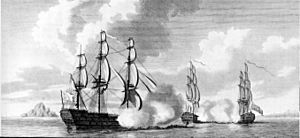Battle of the Mona Passage facts for kids
Quick facts for kids Battle of the Mona Passage |
|||||||
|---|---|---|---|---|---|---|---|
| Part of American Revolutionary War | |||||||
 The capture of the French 64-gun ships Caton and Jason by the Valiant in the Mona Passage, 19 April 1782 |
|||||||
|
|||||||
| Belligerents | |||||||
| Commanders and leaders | |||||||
| Strength | |||||||
| 10 ships of the line 1 frigate 1 fire ship |
2 ships of the line 2 frigates 1 corvette |
||||||
| Casualties and losses | |||||||
| 10 killed 14 wounded |
2 ships of the line captured 1 frigate captured 1 corvette captured 1,300 captured |
||||||
The Battle of the Mona Passage was a sea battle that happened on April 19, 1782. It was part of the American Revolutionary War, fought between Great Britain and France. This battle took place right after another big fight called the Battle of the Saintes.
A British fleet, led by Rear-Admiral Sir Samuel Hood, chased a smaller French fleet. The French ships, commanded by Georges-François de Framond, had escaped the earlier battle. The two fleets met near the Mona Passage. The British ships were faster and managed to catch and capture four French ships. Two of these were large 64-gun warships.
Contents
What Happened in the Battle?
Before the Battle: The Saintes
Just before this battle, from April 9 to April 12, 1782, a major sea battle took place. This was the Battle of the Saintes. A British fleet, led by Admiral George Rodney, fought and defeated a French fleet. The French fleet was commanded by the Comte de Grasse.
The French had planned to invade Jamaica, a British island. But their defeat at the Saintes stopped these plans. After their victory, the British fleet sailed to Jamaica. From there, Admiral Rodney gave an order. He told Rear-Admiral Sir Samuel Hood to find any French ships that were damaged or had escaped the battle. So, on April 17, Hood's group of ten ships set off. They headed towards Saint-Domingue (which is now Haiti).
The Chase and Fight
The French ships that Hood was looking for were in the Mona Passage. This is a narrow strait of water between Hispaniola and Puerto Rico. The French ships were sailing towards Cap-Français. They were not in good shape.
The French 64-gun warship Caton, led by Georges-François de Framond, had been damaged earlier. Another 64-gun ship, the Jason, was also damaged. It had crashed into another French ship the day after the first battle.
Hood's British squadron spotted these French ships. The British ships were faster because they had copper sheathing on their hulls. This made them glide through the water more easily. They quickly caught up to the damaged French ships.
The British ship HMS Valiant captured both the Jason and the Caton. This cost the British four men killed and six wounded. Another British ship, HMS Magnificent, captured the French frigate Aimable. This cost the British four killed and eight wounded. The British ship Champion also captured the frigate Astrée. However, the Astrée managed to escape with only minor damage.
After the Battle
After this successful chase, Hood's fleet met up with Admiral Rodney. They met at Port Royal on April 29. Both the British and French fleets had been through a lot of fighting. Because of the damage, it took nine weeks to repair the ships.
The French ships that were captured were taken back to England. They were then used by the British Navy. The Jason was renamed HMS Argonaut. The Caton was used as a prisoner of war hospital ship. It was anchored near Saltash in Cornwall. It continued to serve in this role for many years, even during the Napoleonic Wars. The Aimable was renamed HMS Aimable and served the Royal Navy until 1811.
Another captured ship, the Cérès, which was a former British ship, became HMS Raven. However, the French recaptured her in January 1783 and later sold her. The French commander, Framond, faced a military trial on February 27, 1783. He was found guilty and removed from the Navy.
Images for kids
Ships in the Battle
Britain's Ships
|
France's Ships
|




